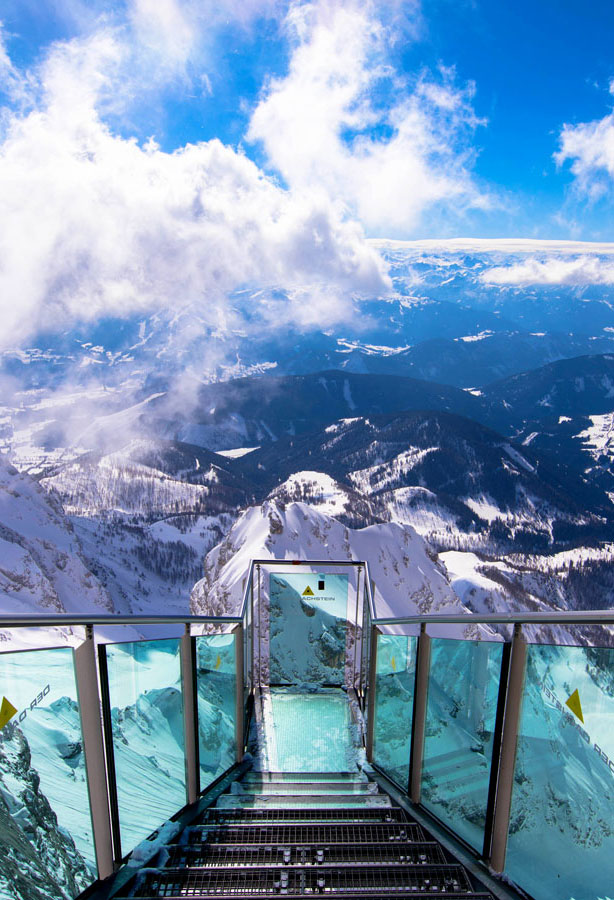Why settle for a run-of-the-mill footpath? Built at dizzying heights around the world, aerial walkways not only provide outstanding views, but are also sure to get your adrenaline pumping. From suspension bridges spanning deep gorges to swaying rope walkways through towering treetops, are you brave enough to cross these 10 stunning sky-high walkways?
Titlis Cliff Walk – Engelberg, Switzerland
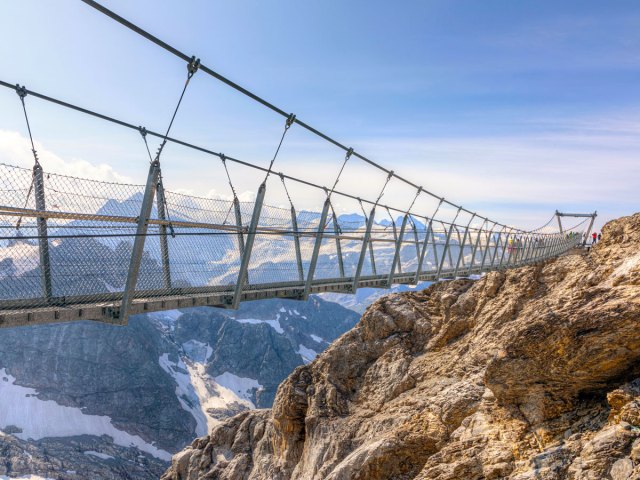
Hanging 9,977 feet above sea level, the Titlis Cliff Walk is the highest suspension bridge in Europe. This astonishing feat of engineering at the summit of Switzerland’s Mount Titlis is made of steel cables and allows pedestrians to cross a 1,650-foot-deep chasm. A mere three feet wide and 328 feet long, the footbridge is a thrilling journey over the glacial abyss below.
To reach the bridge, visitors must first brave a gondola and then a revolving cable car — both of which offer 360-degree views of the magnificent Swiss Alps. Next, they must walk through a glacial cave in order to reach a sky-high platform with panoramic views. Those who are gutsy enough to cross the bridge will be rewarded with the Ice Flyer, a chair lift that offers a unique perspective of the deep crevasses below.
Royal Gorge Bridge – Cañon City, Colorado

Located about an hour from Colorado Springs, Royal Gorge Bridge is the highest suspension bridge in the United States. Built 956 feet above the Arkansas River, the suspension bridge is four times higher than San Francisco’s Golden Gate Bridge and nearly as tall as the Chrysler Building.
The bridge was constructed in 1929 to allow visitors a view of the gorge’s staggering beauty, and today it is listed in the National Register of Historic Places. Since its construction, Royal Gorge Bridge has been reconstructed for added safety measures and even survived a fire in 2013. Since then, the walkway has been trademarked as “America’s Bridge,” with hundreds of thousands of brave souls crossing every year.
Capilano Suspension Bridge Park – Vancouver, Canada
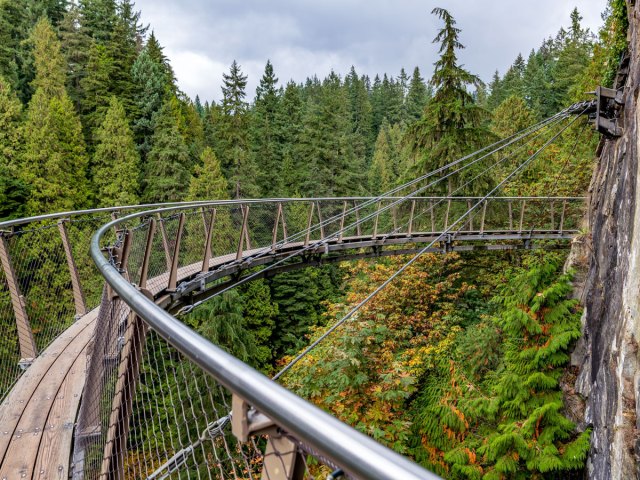
Located among the treetops of a temperate rainforest along the Capilano River in western British Columbia, Capilano Suspension Bridge Park offers multiple sky-high walkways for intrepid travelers. Best known for its eponymous suspension bridge, the 450-foot-tall, 230-foot-long overpass was first constructed by a Scottish civil engineer in 1889. Thankfully, the bridge has since been rebuilt with cables strong enough to hold an airplane, allowing visitors to cross safely.
Other thrilling experiences in the park include Treetops Adventure, which allows visitors to traverse suspension bridges between the park’s old-growth trees, and the Cliffwalk, a death-defying, suspended walkway along a steep canyon.
Místico Arenal Hanging Bridges Park – La Fortuna, Costa Rica
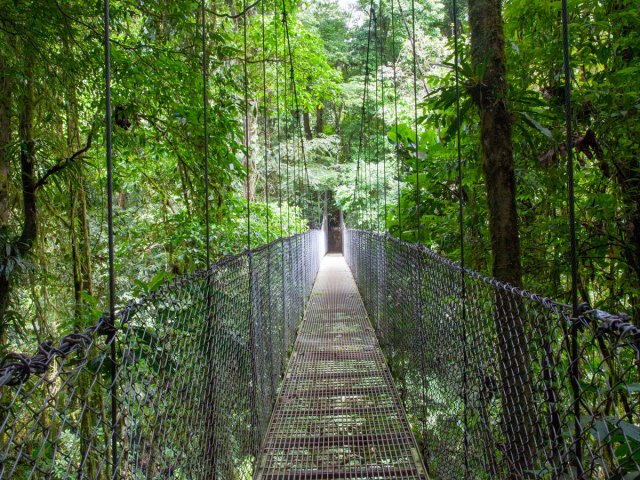
Místico Arenal Hanging Bridges Park contains a vast complex of connecting walkways (six of which are hanging bridges) that treats visitors to sky-high views of the rainforest’s treetops and understory below. Located 30-minute drive from La Fortuna in central Costa Rica, the park also offers dramatic views of the Costa Rican countryside and Arenal Volcano in the distance.
The collective length of the park’s 16 bridges stretches for two miles and takes roughly two hours to complete. Along the way, visitors may encounter animals such as tropical birds, sloths, and monkeys. To see nocturnal animals like the red-eyed leaf frog and kinkajou (also known as a “honey bear”), the Twilight Tour and the Místico Night Walk offer visitors the perfect opportunity to spot these exotic creatures when the sun goes down.
Carrick-a-Rede – Ballintoy, Northern Ireland
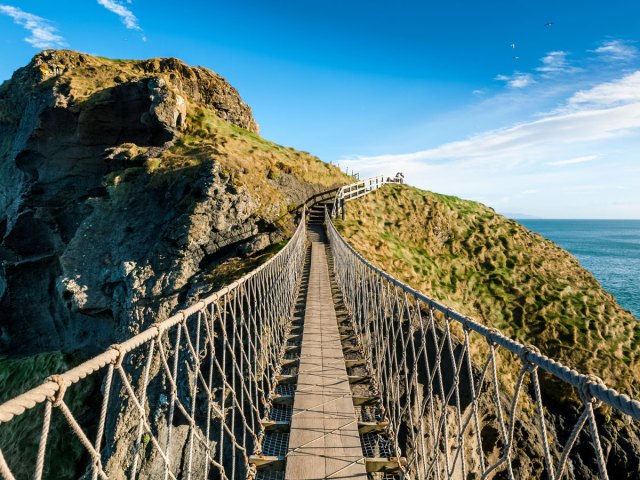
A small, rocky island off the shore of Northern Ireland, Carrick-a-Rede translates to “Rock in the Road” in Scottish Gaelic. Named for its position as a barrier preventing migrating salmon from swimming through the ocean channel, Carrick-a-Rede was once considered a boon for salmon fishermen. In 1755, local fishermen built a rope bridge to connect the mainland to Carrick-a-Rede to increase their daily catch.
An upgraded version of the rudimentary bridge still stands today, but since the salmon population has declined, Carrick-a-Rede is owned and operated by the National Trust. Built 100 feet above sea level, the hanging bridge is a short but exhilarating journey across the chasm below. Since it transports visitors over a rocky sea, most people who cross over to Carrick-a-Rede won’t notice the views of the craggy coastline until they’ve made it safely across.
Langkawi Sky Bridge – Langkawi, Malaysia

Located on Pulau Langkawi, the main island in the Langkawi archipelago off the coast of Malaysia, the Langkawi Sky Bridge is the longest curved free-span bridge in the world. At 410 feet in length, the bridge was built after materials were airlifted to the top of Gunung Mat Chinchang, the second-tallest mountain in Langkawi. Today, a cable car also carries visitors to the Sky Bridge.
Connecting two peaks, the Sky Bridge features a prominent curve designed to offer visitors 360-degree perspectives of the surrounding forest and the Strait of Malacca. The five-foot-wide bridge also allows plenty of space for foot traffic and includes glass floor panels that give visitors a glimpse of the staggering 2,300-foot drop below.
El Caminito del Rey – Málaga, Spain
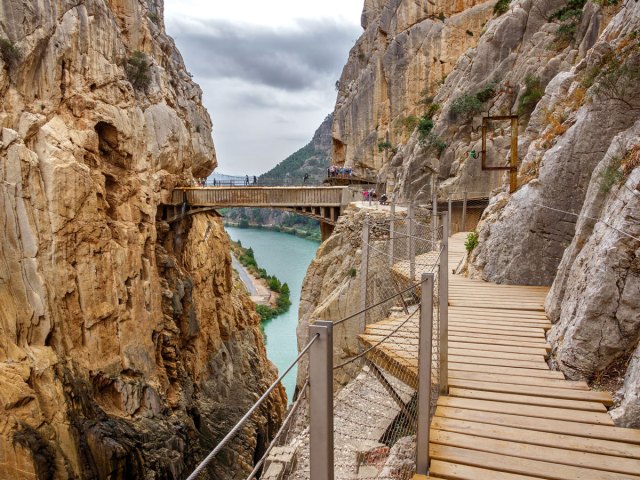
Spanning a narrow gorge in southern Spain, El Caminito del Ray was once considered the world’s most dangerous footpath. Built in the early 20th century as a way to transport workers to the dam near Gaitanejo Falls, the walkway was officially opened to the public by King Alfonsi XIII in 1921, earning the name “King’s Little Walk.”
The path has since been restored and is a much safer journey for visitors, despite its location along a sheer cliff. To walk the footpath in its entirety requires a minimum of three hours and includes crossing a suspended 300-foot-tall walkway over the gorge. Trekkers often spot wildlife along the way, including golden eagles, wild boars, and Iberian ibex. A bus shuttles visitors between the trailhead and terminus.
OCBC Skyway – Singapore

Located in Singapore’s Gardens by the Bay, the Supertree Grove features 18 “supertrees” that rise 164 feet above the ground and are illuminated at night. Covered in 162,900 different varieties of plants, such as orchids, ferns, and tropical flowers, these human-made “trees” are designed to collect rainwater for irrigation purposes.
Connecting the supertrees is a 400-foot-long platform known as the OCBC Skyway. Built 72 feet above ground, the skyway offers sweeping views of Supertree Grove and Singapore’s Marina Bay. At the top of the tallest supertree is an observatory and rooftop bar, which is an ideal place to take in the spectacular light show. Scheduled twice an evening, this award-winning light and sound show is a dazzling way to see Supertree Grove in all its glory.
CN Tower Edgewalk – Toronto, Canada

The most recognizable landmark of the Toronto skyline, the CN Tower measures 1,185 feet tall at the very top of its antenna. A mere 17 feet below this height is the CN Tower Edgewalk, a death-defying journey for those in search of a serious rush of adrenaline. As the highest, hands-free circle walk in the world, the Edgewalk allows visitors to circumnavigate the 16-story building on foot.
Of course, extreme safety precautions are taken in order to complete this terrifying trek around the five-foot ledge. Edgewalkers must wear jumpsuits and be fitted with safety harnesses that anchor to the side of the building. Once secure, they are allowed to walk hands-free around the tower and can even lean off the edge for a thrilling, once-in-a-lifetime experience.
Stairway to Nothingness – Schladming, Austria

Located in Dachstein Glacier Resort, the Stairway to Nothingness is not for the faint of heart. Boasting a vertigo-inducing drop of 1,312 feet, this infamous stairway is accessible via a 328-foot-long suspension bridge that connects the massif. As the highest bridge in Austria, the massive, steel-and-concrete structure weighs five tons and took six months to complete in 2013 — drawing plenty of intrepid visitors to its dizzying heights.
After crossing the bridge, visitors can muster up the courage to journey down the 14 steps down into “nothingness.” In this case, nothingness is a clear glass viewing platform offering incredible views of the Austrian Alps and full visibility of the precipitous drop below.
More from our network
Daily Passport is part of Optimism, which publishes content that uplifts, informs, and inspires.






